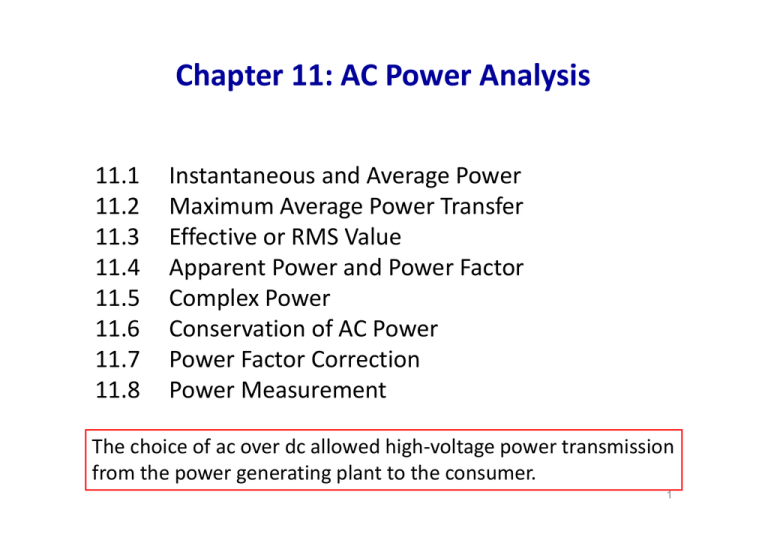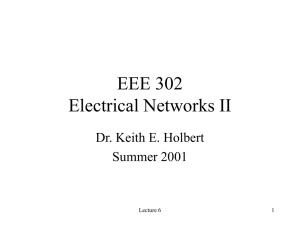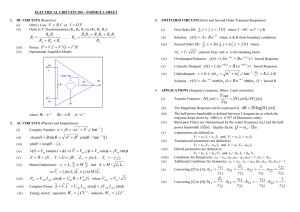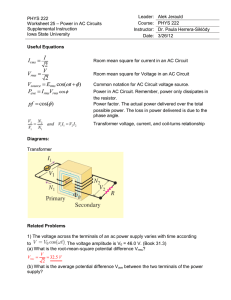Chapter 11: AC Power Analysis
advertisement

Chapter 11: AC Power Analysis 11.1 11.2 11.3 11.4 11.5 11.6 11.7 11.8 Instantaneous and Average Power Maximum Average Power Transfer Effective or RMS Value Apparent Power and Power Factor Complex Power Conservation of AC Power Power Factor Correction Power Measurement The choice of ac over dc allowed high‐voltage power transmission from the power generating plant to the consumer. 1 11.1 Instantaneous and Average Power (1) • The instantaneously power (in watts), p(t) v ( t ) Vm cos( t v ) i ( t ) I m cos( t i ) p (t ) v(t ) i (t ) Vm I m cos ( t v ) cos ( t i ) 1 1 Vm I m cos ( v i ) Vm I m cos (2 t v i ) 2 2 constant power sinusoidal power at 2ωt p(t) > 0: power is absorbed by the circuit; p(t) < 0: power is absorbed by the source. 1 T 1 P p(t ) dt Vm I m cos ( v i ) T 0 2 • The average power, P, is the average of p(t) over one period. 1. P is not time dependent. 2. When θv = θi , it is a purely resistive load case. 3. When θv– θi = ± 90o, it is a purely reactive load case. 4. P = 0 means that the circuit absorbs no average power. 2 11.1 Instantaneous and Average Power (2) 1 P Vm I m cos( v i ) 2 P 1 1 2 1 2 R: P Vm I m I m R I R 2 2 2 1 Re VI 2 1 L or C: P Vm I m cos 90 0 2 I 20 30 Example: A current flows through an impedance Z 40 22 . Find the average power delivered to the impedance. Answer: 7.417 kW 3 11.1 Instantaneous and Average Power (3) Example: Determine the average power generated by each source and the average power absorbed by each passive element in Fig. by mesh analysis 4 1.5 Power and Energy (1) • Power is the time rate of expending or absorbing energy, measured in watts (W). dw dw dq p vi • Mathematical expression: dt dq dt Passive sign convention P = + vi absorbing power p = – vi supplying power 5 11.2 Maximum Average Power Transfer (1) ZTh RTh jX Th I ZL RL jX L VTh VTh Z Th Z L RTh jX Th RL jX L 2 VTh RL / 2 1 2 P I RL 2 2 2 R R X X Th L Th L • The maximum average power can be transferred to the load if XL = –XTh and RL = RTh, i.e., Z L RL jX L RTh jX Th Z Th 2 • The load impedance must be equal to the V Pmax Th complex conjugate of the Thevenin impedance. 8RTh 2 2 • If the load is purely real, i.e. XL = 0, then RL RTh X Th ZTh6 4.7 Maximum Power Transfer (1) ‐ There are applications such as communications where it is desirable to maximize the power delivered to a load. ‐ If the entire circuit is replaced by its Thevenin equivalent except for the load, the power delivered to the load is: 2 VTh P i 2 RL RL R R L Th ‐ Maximum power is transferred to the load resistance equals the Thevenin resistance as seen from the load. The power transfer profile with different RL 2 RL RTh Pmax V Th 4 RL 7 11.2 Maximum Average Power Transfer (2) Example: For the circuit shown below, find the load impedance ZL that absorbs the maximum average power. Calculate Pmax. 8 11.3 Effective or RMS Value (1) • The total power dissipated by R is given by: 1 P T T 0 R T 2 2 i Rdt i dt I eff R 0 T 2 Hence, Ieff is equal to: I eff 1 T T i 2 dt I rms 0 Note: The root mean square (rms) value is a constant itself which depending on the shape of the function i(t). The effective of a periodic current is the dc current that delivers the same average power to a resistor as the periodic current. • The rms value of a i(t) = Imcos(ω t) is given by: I rms I m 2 • The average power can be written in terms of the rms values: 1 P Vm I m cos( v -i ) Vrms I rms cos( v i ) 2 Note: If you express amplitude of a phasor source(s) in rms, then all the answer 9 as a result of this phasor source(s) must also be in rms value. 11.3 Effective or RMS Value (2) Example: Find the rms value of the current waveform. If the current flows through a 9-Ω resistor, calculate the average power absorbed by the resistor. Example: Find the rms value of the full‐wave rectified sine wave. Calculate the average power dissipated in a 6-Ω resistor. 10 11.4 Apparent Power and Power Factor (1) • Apparent Power (in VA), S, is the product of the rms values of voltage and current. • It is measured in volt‐amperes or VA to distinguish it from the average or real power which is measured in watts. P Vrms I rms cos( v i ) S cos( v i ) Apparent Power, S Power Factor, pf • Power factor is the cosine of the phase difference between the voltage and current. It is also the cosine of the angle of the load impedance. 11 11.4 Apparent Power and Power Factor (2) Purely resistive load (R) Purely reactive load (L or C) Resistive and reactive load (R and L/C) θv– θi = 0, pf = 1 θv– θi = ±90o, pf = 0 θv– θi > 0 θv– θi < 0 P/S = 1, all power are consumed P = 0, no real power consumption • Lagging - inductive load • Leading - capacitive load Example: Determine the power factor of the entire circuit by the source. Calculate the average power delivered by the source. 12 11.5 Complex Power (1) • Complex power (in VA) S is the product of rms voltage phasor and complex conjugate of rms current phasor: 1 S VI VrmsI rms Vrms I rms v i 2 where V Vm v Vrms I I m i I rms V Vrms v 2 I I rmsi 2 S Vrms I rms cos( v i ) jVrms I rms sin( v i ) S = P + j Q P: is the average power in watts delivered to a load and it is the only useful power. Q: is the reactive power exchange between the source and the reactive part of the load. It is measured in VAR. Q = 0 for resistive loads (unity pf). Q < 0 for capacitive loads (leading pf). Q > 0 for inductive loads (lagging pf). 13 11.5 Complex Power (2) S Vrms I rms cos( v i ) jVrms I rms sin( v i ) S = P + j Q Apparent Power: S = |S| = Vrms × Irms = P 2 Q 2 Real power: P = Re(S) = I2rms R = S cos(θv – θi) Reactive Power: Q = Im(S) = I2rms X = S sin(θv – θi) Power factor: pf = P/S = cos(θv – θi) Power Triangle Impedance Triangle Power Factor 14 11.5 Complex Power (3) Vrms 11085o V, I rms 0.415o A Example: For a load, . Determine: (a) the complex and apparent powers, (b) the real and reactive powers, and (c) the power factor and the load impedance. 15 11.6 Conservation of AC Power The complex, real, and reactive powers of the sources equal the respective sums of the complex, real, and reactive powers of the individual loads. For parallel connection: S VI* ( V1 V2 )I* V1I* V2 I* S1 S 2 The same results can be obtained for a series connection. Example: In the circuit, the 60-Ω resistors absorbs an average power of 240 W. Find V and the complex power of each branch of the circuit. What is the overall complex power of the circuit? (Assume the current through the 60-Ω resistor has no phase shift.) 16 11.7 Power Factor Correction (1) • Most domestic and industrial loads, such as washing machines, air conditioners, and induction motors are inductive. They have a low, lagging power factor. The load cannot be changed, but the power factor can be increased without altering the voltage or current to the original load. • Power factor correction: the process of increasing the power factor without altering the voltage or current to the original load. • To mitigate the inductive aspect of the load, a capacitor is added in parallel with the load. The power factor has improved. 17 11.7 Power Factor Correction (2) • With the same supplied voltage, the current draw is less by adding the capacitor. Since power companies charge more for larger currents because it leads to larger power losses. Overall, the power factor correction benefits the power company and the consumer. By choosing a suitable size for the capacitor, the power factor can be made to be unity. QC = Q1 – Q2 = P (tan θ1 - tan θ2) = ωCV 2rms Q1 = S1 sin θ1 = P tan θ1 C P = S1 cos θ1 Q2 = P tan θ2 Qc P(tan 1 tan 2 ) 2 2 Vrms Vrms Power factor correction is necessary for economic reason. • The real power dissipated in the load is not affected by the shunt capacitor. • Although it is not as common, if a load is capacitive in nature, the same treatment with an inductor can be used. 18 11.8 Power Measurement (1) • The wattmeter is the instrument for measuring the average power. • The meter consists of two coils; the current and voltage coils. The current coil is designed with low impedance and is connected in series with the load. • The voltage coil is designed with very large impedance and is connected in parallel with the load. Basic structure Equivalent Circuit with load 19 11.8 Power Measurement (2) If v(t ) Vm cos(t v ) and i (t ) I m cos(t i ) P Vrms I rms cos( v i ) 12 Vm I m cos ( v i ) • The induced magnetic field from both causes a deflection in the current coil. • Ideally, the configuration does not alter the load and affect the power measured. • The physical inertia of the moving coil results in the output being equal to the average power. 20





